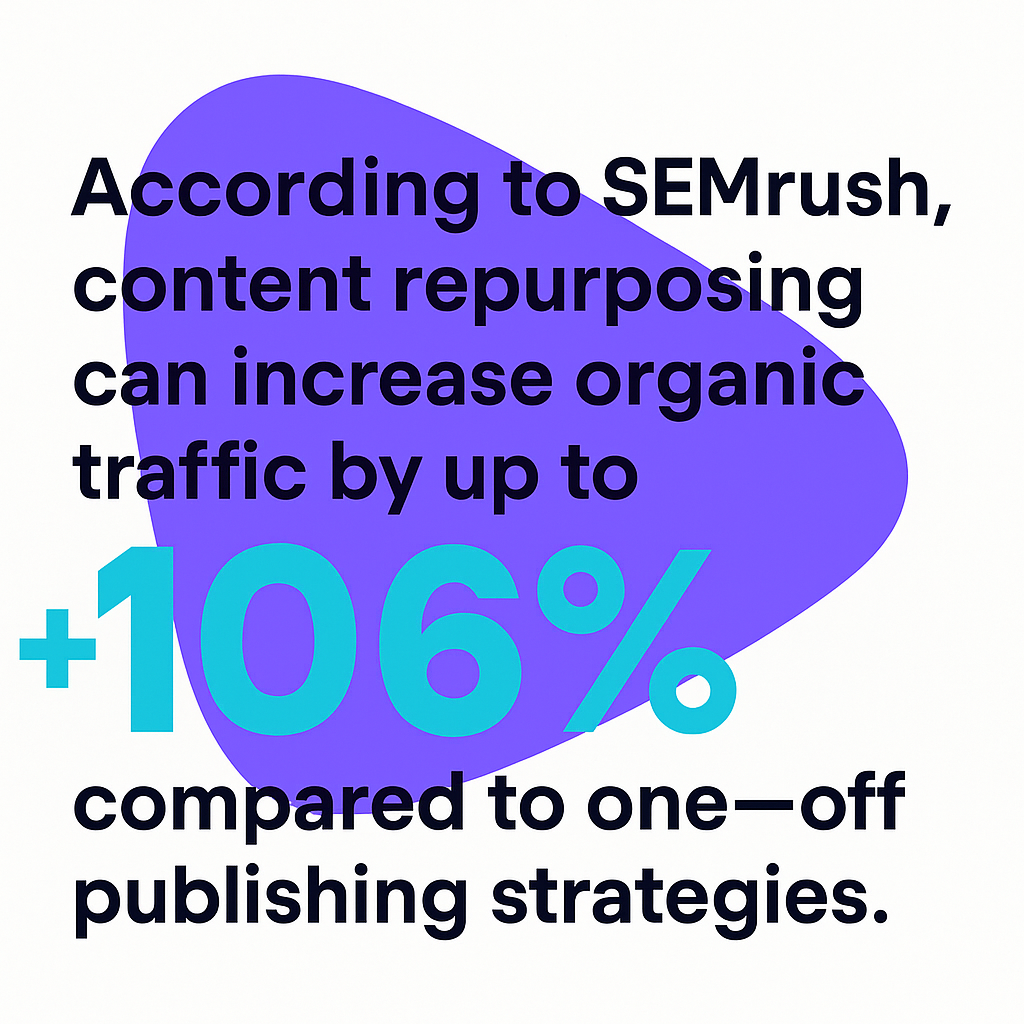
Why Video Marketing Feels Hard and How to Make It Effortless
Brenna, a CMO at a high-growth B2B enterprise, stared at the dashboard with a familiar mix of pride and pressure.
Her team had just shipped a 16-page report that took three departments, six weeks, and no fewer than fourteen stakeholders to align. It was beautiful, data-rich, insight-packed, on-brand. And within 72 hours, it was already buried under the weight of “what’s next?”
The Slack ping came in right on cue:
“Can we get a video version of this?”
“Something snappy for LinkedIn?”
“Maybe an internal version too for the all-hands deck?”
She didn’t roll her eyes, but she wanted to.
Video always sounds good in theory. In practice, it means new scripts, new storyboards, and a post-production queue that moves slower than legal approval. So it becomes another item in a backlog that marketing leaders don’t have the time, or team, to tackle.
But here’s the part that most marketing execs haven’t internalized yet: You already made the video, you just haven’t turned it into one yet.
That killer stat in your blog post? That anecdote from your founder’s keynote? The slide from your sales deck that gets heads nodding every time? All of it is video-ready. You just need to translate the format, not reinvent the message.
This blog is your permission slip to stop treating video like a net-new campaign, and start seeing it for what it really is: a multiplier. Done right, video isn’t “more work.” It’s what makes your work go farther.
We’ll walk through how enterprise marketing teams are reframing their video strategy, not as a creative moonshot, but as a systematic advantage. And we’ll break down the real workflows that let lean content teams 10x their output without hiring, hustling, or burning out.
Because the next era of content marketing won’t be written, it’ll be watched.
How to Turn Existing Content Into High-Performing Video Assets
When marketing leaders say they “don’t have time for video,” what they often mean is: We don’t have time to create more content.
And they’re right. Your team’s already running at full tilt managing campaigns, reviewing creative, pushing through rewrites, meeting with sales, and building decks for the board. Video feels like another sprint on an already uphill climb.
But here’s the kicker: You already have more content than you realize. The problem isn’t the lack of ideas. It’s the lack of visibility.
Let’s play this out.
What’s Actually Sitting in Your Content Graveyard?
If your team publishes even one blog post per week, that’s 52 opportunities per year to repurpose. Add newsletters, event recordings, webinar transcripts, internal memos, press releases, FAQs, thought leadership threads on Slack, and competitive battlecards.
Each of these assets contains dozens of moments worth turning into motion.
- A blog post can become a teaser clip, a short-form video, or a voiceover explainer
- A sales deck can be transformed into a video series that educates new prospects
- A webinar can be atomized into 5–7 thematic social clips with animated pull-quotes
Take a page from Salesforce’s playbook: their “State of Sales” report, originally a 68-page PDF, was repurposed into 10+ LinkedIn native videos, a YouTube series, an internal all-hands highlight reel, and customer-facing bite-sized explainers. Same core message. Dozens of formats. Broader reach.
According to SEMrush, content repurposing can increase organic traffic by up to 106% compared to one-off publishing strategies.

But most teams don’t have a system for mining this gold. They build from scratch. Every time. Which is why the backlog keeps growing.
What CMOs Get Wrong About Content Cadence
Enterprise marketing teams often over-index on publishing net-new content instead of looking at how to extend the lifecycle of what’s already working. That leads to content that dies too quickly and teams that burn out too soon.
“After interviewing thousands of leaders, one thing became clear: the most valuable insights often get lost if they aren’t captured and reused as repurposed content.”
— Diane Hamilton, Forbes
Your calendar isn’t empty. It’s overflowing. You just haven’t unlocked the repurposing layer.
Instead of asking “what’s next?”, start asking: “What haven’t we moved yet?”
Why Content Repurposing Improves Reach, Engagement, and ROI
Let’s be honest, “repurposing” gets a bad rap. It sounds like a compromise. A shortcut. Something scrappy startups do when they can’t afford an agency. But if you think high-growth, brand-driven enterprises aren’t repurposing at scale, you haven’t been behind the scenes lately.
The best marketing leaders don’t see repurposing as repetition, they see it as orchestration.
A Modern Marketing Truth: Reach Is a Format Game
Here’s a hard truth for marketers: Your audience isn’t seeing everything you publish. Not even close.
LinkedIn Page posts typically reach just 5–7% of followers, even with consistent posting. And B2B email open rates tend to fall within the 30–40% range, depending on industry and segmentation quality.

So if you publish something once, in one format, you’re essentially throwing a dart and hoping it lands in the right inbox, at the right time, in the right mindset.
Repurposing changes the odds.
When you translate a blog into:
- a motion graphic for LinkedIn,
- a talking-head explainer for YouTube,
- a looping quote card for Instagram,
- and a short vertical clip for your sales team’s WhatsApp group…
You’re not repeating yourself. You’re reinforcing your message across multiple moments and mentalities. This isn’t just more content. It’s format diversity, and it creates audience surface area.
Case Study: How Emerson Scaled Thought Leadership Into Video That Drives Engagement
One common misconception? That repurposing only works for scrappy content teams. But even enterprise-level brands are building scalable repurposing workflows, and seeing real performance gains.

Take Emerson Automation Solutions, a global engineering and technology leader. Their content team publishes a steady cadence of technical blogs and thought leadership articles. The challenge? Turning those assets into engaging, visual content without adding to the production queue.
That’s where Lumen5 came in.
By integrating Lumen5 into their content workflow, Emerson was able to:
- Automatically convert blog posts into polished, branded video summaries
- Pull key quotes, stats, and insights to build multiple social-friendly clips
- Maintain brand consistency across a diverse portfolio of engineering solutions
Each blog post didn’t just get a second life, it got a visual distribution layer that extended its reach across LinkedIn, internal newsletters, and channel partner enablement.
“We have scaled Lumen5’s use across our marketing organization, realizing benefits across many team layers. As company communicators, this agile tool enhances each customer’s experience and engagement.”
— Michelle MontesDirector of Global Integrated Marketing, Emerson
The result? Higher engagement, faster turnaround, and a stronger bridge between thought leadership and brand awareness. This is repurposing at an enterprise scale done strategically, not reactively.
👉 See the full Emerson case study to explore how their team scaled video with speed, precision, and brand consistency.
Leading Isn’t Always Launching, It’s Amplifying
As a marketing leader, your job isn’t just to generate. It’s to amplify. To ensure your team’s best thinking actually lands and sticks.
Lazy marketing makes noise. Strategic repurposing builds resonance.
The Best Workflow for Scaling Video Marketing Without Adding Headcount
“Do more with less” isn’t just a catchphrase, it’s your job description now.
Your board wants more brand presence. Your CEO wants more video. Your team wants fewer 11pm Slack messages. Welcome to the modern CMO’s triangle of tradeoffs: velocity, quality, and sanity. You can have two, but only if you build the right systems.
Velocity Is a Symptom of Workflow Design
Most content teams don’t have a velocity problem. They have a replication problem. They finish a blog and immediately move to the next. Launch a campaign, then rebuild from zero the next quarter.
But the highest-performing teams don’t treat content as one-off assets. They treat it as creative inventory, modular and reusable.
Enter: The Content-to-Video System.
With tools like Lumen5, your existing assets can fuel a repeatable workflow that looks like this:
- Source: Start with any high-performing longform asset (blog, report, webinar, FAQ)
- Slice: Identify 3–5 “message blocks” (e.g. a stat, quote, benefit, or story)
- Script: Turn blocks into 50–100 word voiceover narratives
- Build: Use Lumen5’s AI-powered video builder to generate short clips
- Distribute: Deploy across social, internal channels, and even sales enablement
This isn’t theoretical. We’ve seen clients build 8–10 video assets per week from one piece of content, without hiring motion designers or spending hours editing.

Burnout Doesn’t Come From Workload, It Comes From Reinventing the Wheel
Your team isn’t overwhelmed by volume. They’re overwhelmed by redundancy, having to start from scratch every single time. Systems solve that.
You don’t need more headcount to increase output. You need fewer handoffs, and a smarter engine.
How to Get Stakeholder Buy-In for a Motion-First Content Strategy
You can build the perfect system. You can have the right tools. But if no one’s aligned internally, especially in legal, comms, brand, and product, your motion-first content plan will stall before it starts.
Scaling video isn’t just a marketing challenge. It’s a change management challenge.
The Cross-Functional Reality of Video at Scale
When you turn one asset into five videos, it’s not just about reach, it’s about visibility across departments:
- Your internal comms team wants quick updates for town halls or employee onboarding
- Your sales enablement team wants short-form explainers to plug into outreach
- Your execs want their vision turned into shareable leadership content
- Your legal or compliance teams want to know nothing’s going off-brand or off-message
Bringing these stakeholders into the process early turns resistance into readiness.
Friction Comes From Lack of Visibility, Not Lack of Value
In many orgs, repurposing fails not because it’s a bad idea, but because the system isn’t visible:
- People don’t know what content’s being created
- There’s no centralized place to track motion assets
- There’s confusion about what’s approved, or usable
The solution? Treat motion like a shared resource, not a siloed function.
Create a content matrix that maps each major asset (e.g., blog, report, webinar) to its repurposing potential by department. For example:
| Source Asset | Video Types | Teams Benefiting |
|---|---|---|
| Blog Post | Explainer, Social Clips | Marketing, Sales |
| Town Hall Recording | Highlights Reel | Internal Comms, HR |
| Product Update Slide | Voiceover Walkthrough | CS, Enablement |
This small act of visibility and alignment creates momentum and unlocks distributed use across the business.
Great Video Strategies Aren’t Just Creative, They’re Collaborative
Motion-first marketing doesn’t succeed because one team works harder. It succeeds because the entire org moves with it. When everyone sees video as a shared outcome, not a “marketing thing,” your content doesn’t just move, it scales.
How to Create More Video Content Without Increasing Your Budget
When most CMOs hear “let’s do more video,” their brain instantly goes into cost-defense mode.
Because traditionally, video is expensive. Agencies charge $10K+ per asset. Internal teams need editors, animators, producers. Reviews drag. Timelines balloon. And by the time the final cut is approved, the trend has passed and the moment is gone.
But that’s not a video problem. It’s a production model problem.
Legacy Models Aren’t Built for Velocity
Agencies are amazing for brand films and campaigns. But they’re not built to produce 15 snackable videos a week. And in-house creative teams? Already maxed. The idea of pulling someone off a product video to animate a social cutdown feels like robbing Peter to post on Paul.
This is where async, AI-powered tools flip the equation. No After Effects. No render farms. No creative bottlenecks.
The Real Cost of Inaction
Let’s reframe the question. Instead of “How much will more video cost us?” ask:
“What’s the cost of not translating our best content into formats that people actually watch?”
- Video on LinkedIn gets 3x more engagement than text-only posts (Source: Search Engine Journal)
- Including video in email can increase click rates by up to 300% (Source: Marketing Scoop)
- 59% of execs say they’d rather watch a video than read text (Source: Wordstream)
So when static content is your only format, you’re not saving money, you’re leaving performance on the table.

Conclusion: The Teams That Win Don’t Work More, They Work in Motion
There’s a quiet shift happening in high-performing marketing teams. They’re no longer measured by how much content they create. They’re measured by how far their content travels. And the teams pulling ahead aren’t the ones working overtime or adding more formats to the backlog.
They’re the ones who’ve built systems that turn what they already have into high-performing, multi-channel campaigns, without the drag. They’ve stopped treating video as a separate initiative and started treating it as a force multiplier.
Because the truth is: every message your team creates is either motion-capable or motion-constrained. The difference is what you do next.
So here’s the challenge:
Before your team produces one more campaign deck, blog, or internal doc—pause. Don’t ask “What are we saying?” Ask: “How will this move?”
Will it live beyond the inbox? Will it connect across departments? Will it spark emotion, curiosity, momentum?
If it can’t move, it can’t scale. If it doesn’t move, it won’t stick. And if your marketing strategy is still built around static content, you’re not just behind, you’re invisible.
This isn’t about replacing what works. It’s about extending it in a smart, creative, and repeatable way. You already have the content. Now build the system that makes it move, without burning out your team or blowing out your budget. Because in this new era of marketing, ideas that move are the ones that lead.





